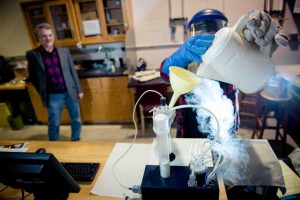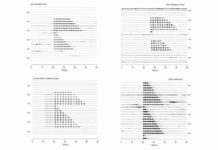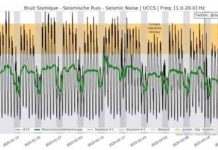
Gleaning data from old rocks may result in bias. Now, geophysicists have a way to improve their methods to overcome challenges in studying the history of the Earth’s core and magnetic field that make up the geodynamo.
Since researchers cannot visit the core, they use rocks at the surface as a proxy. Specifically, volcanic rocks record the intensity and changes in Earth’s magnetic field. The record extends back billions of years to the early days of the planet’s young core and the development of the geodynamo. The problem is that most data gleaned from these old rocks can be biased.
In a new study published in Science Advances and led by geophysicists from Michigan Technological University, the research team lays out how bias is introduced and what to do about it.
Start with the Jurassic—a time of terrible lizards, high carbon dioxide levels and frequent magnetic pole flipping. The rock record shows that with more flips, the intensity of the magnetic field waned. It’s an inverse relationship that geodynamo models predict; however, it has been difficult to back up with data from field samples, which to date have not shown a correlation between magnetic reversals and past magnetic fields’ strength, or paleointensity.
The discrepancy has been debated but remained unresolved, says Aleksey Smirnov, an associate professor of geophysics at Michigan Tech and lead author of the study. The bias, introduced by the conventional Thellier method for analyzing rock sample magnetism, produces lower than expected paleointensity strengths and may resolve this controversy.
“Previous data may need to be reconsidered,” Smirnov says, adding that in the new study, his team tested systemic bias on synthetic samples first. “See, when you work with natural rocks, it’s difficult to separate the effects of nonideal grains and alterations.”
In theory, the Thellier method requires very small magnetic grains and they should plot as a line during analysis; however, because most rocks contain much larger nonideal grains the plots are warped. This problem has been known but largely ignored, says Smirnov, instead researchers tend to only use a section of the curved plot to best estimate the linear relationship. This consistently produces lower than expected measurements and systemic bias in paleointensity datasets, Smirnov says.
The key to gathering better data, he suggests, is using low-temperature demagnetization along with the Thellier method. The additional steps are immersing the sample in liquid nitrogen in a magnetic field-free environment, then letting it naturally warm back up to room temperature before following through with magnetometer tests. The procedure stabilizes the sample. Another option is to calculate the bias introduced by grain size. Unfortunately, because most datasets don’t include grain size for each sample, older data will need to be re-analyzed.
“This is a more rigorous way of doing this particular science,” Smirnov says. “I’ve been doing this a long time—and if we want good data, we need to use good methods.”
Reference:
“Intrinsic paleointensity bias and the long-term history of the geodynamo” Science Advances , DOI: 10.1126/sciadv.1602306
Note: The above post is reprinted from materials provided by Michigan Technological University.










